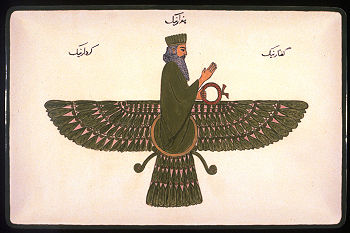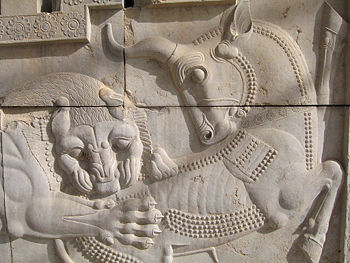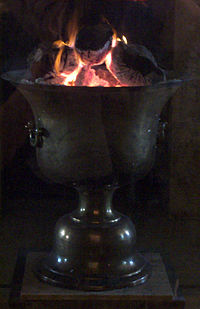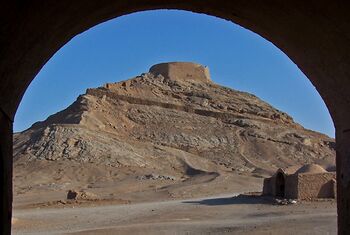Zoroastrianism: Difference between revisions
imported>Minhaj Ahmed Khan Lodi (→Classical antiquity: Replaced Darius image with one of Angra Mainyu attacking a bull as the former is not related to the faith) |
imported>Minhaj Ahmed Khan Lodi (→Similarities to other faiths: Added material on the yasna and yajna) |
||
| Line 145: | Line 145: | ||
==Similarities to other faiths== | ==Similarities to other faiths== | ||
Zoroastrianism has many striking similarities to faiths around it. It incorporates many features of both [[Abrahamic]] as well as [[Dharmaic]] faiths. It incorporates a high degree of [[syncretism]]. For instance, it's been speculated that Zoroastrian concepts of [[Zoroastrian eschatology|eschatology]] and [[demonology]] had influence on Abrahamic religions. Zoroastrianism has many concepts similar to the [[ancient Vedic religion]], such as the veneration of fire.<ref name=similarities>Boyce, Mary. ''Zoroastrians: Their Religious Beliefs and Practices''. (1985). '''252''' pp. ISBN 0415239028''</ref><ref name=similarities2>Duchesne-Guillemin, Jacques (1988), ''"Zoroastrianism", Encyclopedia Americana'', vol. 29, Danbury: Grolier pages '''813–815'''</ref> | Zoroastrianism has many striking similarities to faiths around it. It incorporates many features of both [[Abrahamic]] as well as [[Dharmaic]] faiths. It incorporates a high degree of [[syncretism]]. For instance, it's been speculated that Zoroastrian concepts of [[Zoroastrian eschatology|eschatology]] and [[demonology]] had influence on Abrahamic religions. Zoroastrianism has many concepts similar to the [[ancient Vedic religion]], such as the veneration of fire.<ref name=similarities>Boyce, Mary. ''Zoroastrians: Their Religious Beliefs and Practices''. (1985). '''252''' pp. ISBN 0415239028''</ref><ref name=similarities2>Duchesne-Guillemin, Jacques (1988), ''"Zoroastrianism", Encyclopedia Americana'', vol. 29, Danbury: Grolier pages '''813–815'''</ref> The similarities between the [[yasna]] and the Hindu [[yajna]] are striking, as both rituals are performed during sunrise, and both have similar names. | ||
Some scholars maintain that the Zoroastrian ritual of praying five times daily influenced Islam<ref name=influenceonislam>Brodd, Jefferey - ''World Religions: A Voyage of Discovery'', ISBN 0884897257</ref>, while Muslims state that all existing and extinct religions were similar to Islam initially, created by prophets similar to Zoroaster and Muhammad. | Some scholars maintain that the Zoroastrian ritual of praying five times daily influenced Islam<ref name=influenceonislam>Brodd, Jefferey - ''World Religions: A Voyage of Discovery'', ISBN 0884897257</ref>, while Muslims state that all existing and extinct religions were similar to Islam initially, created by prophets similar to Zoroaster and Muhammad. | ||
Revision as of 14:26, 21 March 2008
Zoroastrianism is the religion and philosophy based on the teachings ascribed to the prophet Zoroaster (Zarathustra, Zartosht). Mazdaism is the religion with recognises Ahura Mazda's supreme authority as the one God.
By the teachings of Zoroaster, the world is in a struggle between good and evil. The forces of good are led by Ahura Mazda, and the forces of evil led by Angra Mainyu (Ahriman).
Beliefs and Practices
Beliefs
- Ahura Mazda is the one universal and transcendental God, the uncreated creator, to whom all worship is directed.
- Ahura Mazda's creation — evident as asha (truth and order) is the antithesis of chaos, evident as druj (falsehood and disorder). The whole universe is involved in the resulting conflict. Humanity plays an important role in the conflict.
- Ahura Mazda will prevail. All souls, including those initially banished, will be reunited with Ahura Mazda.
- The malevolent are represented by Angra Mainyu, the "destructive principle".
- The benevolent are represented by Ahura Mazda's Spenta Mainyu, the "bounteous principle".
- Ahura Mazda emanated seven "sparks", the Amesha Spentas ("Bounteous Immortals"), as expressions and aspects of creation, that are each representative of one aspect of that creation. A league of lesser principles, the Yazatas, each "Worthy of Worship" and each again a representative of a moral or physical aspect of creation, in turn assist the Amesha Spentas.
Practices
- Good thoughts, good words, and good deeds result in happiness and prevent chaos. Free will to choose between good and evil is an important aspect.
- Fire represents Ahura Mazda's purity. All prayer is directed to a source of fire.
- Monasticism in all forms is rejected.
- Zoroastrians do not proselytize.
- The traditional wing of Zoroastrianism discourages and does not recognize inter-faith marriages.
- Zoroastrians do not generally accept converts. One has to be born into the religion. This belief is disputed by some members.
- Members can pray at home instead of going to a temple if they wish.[1]
History
Founding & life of Zoroaster
The religion was founded by Zarathushtra (Zoroaster in Greek; Zarthosht in India and Persia). Conservative Zoroastrians assign a date of 6000 BCE to the founding of the religion; other followers estimate 600 BCE. Historians and religious scholars generally date his life sometime between 1500 and 1000 BCE on the basis of his style of writing. The date of birth of Zoroaster is very controversial. It is known that after Alexander's conquest of the Achaemenid Empire, the Greeks imposed an "age of Alexander" calendar, which Zoroastrian priests replaced with an "age of Zoroaster" calendar. It was estimated that he was born 258 years before Alexander, hence the date of 600 BCE was accepted.[2]
Zoroaster was born in Northeast Iran or Southwest Afghanistan. He was born into a Bronze Age culture with a polytheistic religion, which included animal sacrifice and the ritual use of intoxicants. This religion was quite similar to the early forms of Hinduism of the Indus Valley. Zoroaster's birth and early life are little documented. What is known is recorded in the Gathas - the core of the Avesta, which contains hymns thought to be composed by Zoroaster himself. Born into the Spitama clan, he worked as a priest. He was a family man, with a wife, three sons and three daughters. Zoroaster rejected the religion of the Bronze Age Iranians with their many gods and oppressive class structure, in which the Karvis and Karapans (princes and priests) controlled the ordinary people. He also opposed animal sacrifices and the use of the hallucinogenic Haoma plant (possibly a species of ephedra) in rituals.[3] Zoroaster was initially unsuccessful in gaining converts, apart from his cousin, but later, however, he successfully converted the King, who made it the official religion. His death is, for reasons easily intelligible, nowhere mentioned in the Avesta. In the Shah-Nama he is said to have been murdered at the altar by the Turanians in the storming of Balkh.[4]
Classical antiquity
Although Zoroastrianism is much older, there are no significant sources mentioning the faith prior to the fifth century BCE. Herodotus was the first to write about Persian society, in his account of researches Histories. He mentions similarities to the Zoroastrian faith, including exposure of the dead.
Herodotus names the tribes of Media - Busae, Parataceni, Struchates, Arizanti, Budii, Magi, and the tribes of Persia - Pasargadae, Maraphii, and Maspii, upon who'm all tribes are dependant upon. The most important tribe was the Pasargadae, of which the Achaemenid clan ruled over Persia. The Magi of Media used to have considerable power over the courts of the Median Kings (perhaps they were a priestly class).
Cyrus the great and his son Cambyses II, after the unification of Persia and Media, were responsible for reducing the power of the Magi class. In revolt, the Magi placed an usurper, pretending to be Cyrus's son Smerdis. The usurper was accepted by most people, as he had waived taxes for three years. According to the Behistun inscription, pseudo-Smerdis ruled for seven months, before being overthrown by Darius I. The Magi were persecuted, but continued to exist.
It is not known if Cyrus II was Zoroastrian, however, it was the non-imposing religion of the Empire. It influenced him to the extent that he freed the Jews, who were exiled. It is confirmed that Darius I and later Emperors were Zoroastrians.
It is confirmed that Darius I and later Achaemenid Emperors permitted other religions to coexist, and exercised perfect religious tolerance. It was in the later Achaemenid era that proto-indo-Iranian religious elements were incorporated into the faith. The days of the months of the Zoroastrian calendar are dedicated to them.[5]
Many books on the Zoroastrian faith were destroyed by Alexander the great's army after the seige of Persepolis.[6] After that, there are no sources about Zoroastrianism during the rule of the Seleucid Empire and the Parthian Empire. It is known, however, that after Alexander's conquest, he imposed many restrictions on the Zoroastrians, particularly by closing the Towers of silence, as the Greeks considered the act of leaving dead to be devoured by vultures to be appalling.[7]
Late antiquity
The Sassanid Empire came into power in 228 CE. They aggressively promoted the Zurivanite sect of Zoroastrianism, and were well known for building Fire Temples in every area they conquered. Other religions, especially Manichaenism and Christianity, were persecuted, except those loyal to the Patriarchate of Babylon. The Nestorians had broken away from Roman Catholic Christianity, which condemned them as heretics, and were tolerated by the Sassanids.[8]
Zoroastrianism spread throughout this period, and was practised in different forms from the Caucasus to China. During the Southern and Northern Dynasties, Zoroastrianism founded its roots in the city states of the Silkroad. The spread of Zoroastrianism by missionaries was prohibited, and in the years from 841 A.D on all foreign religions were prohibited, and although some parishes could survive until the Song period Zoroastrianism soon lost its ground and vanished.[9]
Islamic Invasion and decline
When Muslim Arabs invaded Persia in 650 CE, the religion began to decline, with the nobility and rich converting to the faith. Later on, the rural peasants also began to convert to Islam. Although, as per Islamic law, forced conversion was not imposed, there was a heavy pressure to convert to Islam. Once the dominant religion in Central Asia, there are now less than 200,000 Zoroastrians left.
Many centuries later, a small number of Zoroastrians fled to Gujarat, India where most are concentrated today. They are called the Parsis, derived from Farsi, meaning Persian. According to the census of India, 2001, they currently number 69,601, making up 0.006% of the total population. There's a heavy concentration of Parsis in and around the city of Mumbai. Due a low birth rate and high rate of emigration, it is speculated that by 2020, they will number approximately 23,000, and will cease to be labeled as a community and will be called a tribe.
Those who remained behind have survived centuries of persecution and heavy taxes. They now number only about 18,000 and reside chiefly in Yazd, Kernan and Tehran in what is now Iran. The Zoroastrians in Iran speak a dialect of Persian very different from modern Persian called Dari. The Canadian 1991 census counted 3,190 Zoroastrians in that country. The actual number is believed to be much higher. According to the Fezana Journal survey, published quarterly by the Federation of Zoroastrian Associations of North America, there are about 11,000 Zoroastrians in the United States, 6,000 in Canada, 5,000 in England, 2,700 in Australia and 2,200 in the Persian Gulf nations. There are also thousands more spread all around the world.[10]
Religious Texts
Gathas
The Gathas are the most sacred texts of the Zoroastrian faith, consisting of 17 hymns composed by Zoroaster himself. They were later incorporated into the Yasna, and are identifiable by their chapter names in the Yasna.[11][12]
| Chapter numbers | Name of Gatha | Number of stanzas | Number of verses & syllable metres |
|---|---|---|---|
| 28-34 | Ahunavaiti Gatha (cf Ahuna Vairya) | 100 | 3 verses, 7+9 syllable metre |
| 43-45 | Ushtavaiti Gatha 'Having Happiness' | 66 | 5 verses, 4+7 syllable metre |
| 47-50 | Spenta Mainyu Gatha 'Bounteous Spirit' | 41 | 4 verses, 4+7 syllable metre |
| 51 | Vohu Khshathra Gatha 'Good Dominion' | 22 | 3 verses, 7+7 syllable metre |
| 53 | Vahisto Ishti Gatha 'Best Beloved' | 9 | 4 verses, two of 7+5 and two of 7+5+5 syllables |
Zend-Avesta
The Zend-Avesta, called Avesta in short, is the prayer-book of Zoroastrians. It is divided into five parts, the Yasna, the Vispered, Vendidad, Yashts, and Khordah Avesta. The prose suggests that it was written after Zoroaster's death.
The Yasna, the principal liturgical book of the Parsees, in 72 chapters (hait-i, ha), contains the texts that are read by the priests at the solemn yasna (Izeshne) ceremony, or the general sacrifice. The Vispered, a minor liturgical work in 24 chapters (karde), is alike in form and substance completely dependent on the Yasna, to which it is a liturgical appendix. Its separate chapters are interpolated in the Yasna in order to produce a modified - or expanded - Yasna ceremony. The Vendidad, the priestly code of the Parsees, contains in 22 chapters (fargard) a kind of dualistic account of the creation, the legend of Yima and the golden age , and in the bulk of the remaining chapters the precepts of religion with regard to the cultivation of the earth, the care of useful animals, the protection of the sacred elements, such as earth, fire and water, the keeping of a man's body from defilement, together with the requisite measures of precaution, elaborate ceremonies of purification, atonements, ecclesiastical expiations ,and so forth. The Yashts, i.e. " songs of praise," in so far as they have not been received already into the Yasna, form a collection by themselves. They contain invocations of separate Izads, or angels, number 21 in all, and are of widely divergent extent and antiquity. The Khordah Avesta, i.e. the Little Avesta, comprises a collection of shorter prayers designed for all believers - the laity included - and adapted for the various occurrences of ordinary life.[13]
Other Texts
There are other texts which are of religious or semi-religious nature. They were all compiled many centuries later, after the 9th century, with the youngest created in the 17th century. Some claim to contain lost chapters of the Avesta.
The texts in Middle Persian are:
- The Dēnkard ("Acts of Religion")
- The Bundahishn ("Primordial Creation")
- The Mēnog-ī Khirad ("Spirit of Wisdom")
- The Arda Viraf Nāmag ("Book of Arda Viraf")
The Sad Dar ("Hundred Doors or Chapters") is in Mordern Persian and The Rivayats (Traditional Treatises) are in Middle as well as Mordern Persian.
Worship
The Zoroastrians have often been described as 'fire worshipers'. However, this is quite false, as Zoroastrians use fire as a purifying agent, which signifies Ahura Mazda's purity. Use of fire as a purifying agent is central to Zoroastrianism. Worship usually takes place inside a Fire Temple, five times a day (similar to Islam, some scholars signify that Zoroastrianism influenced Islamic salat, while Muslims maintain that every religion, including Zoroastrianism, was similar to Islam initially). Mordern Zoroastrians continue to maintain the fire ritually, and the fire is centrally placed in the temple. Priests cover their mouths with cloth in order to avoid contaminating the fire. Worshipers wash themselves before entering the temple, bringing offerings of sandalwood and money, in turn, they receive ashes which they rub on their faces.[14]
The inner ceremonies
The most important inner ceremony is the Yasna. The Yasna can only be performed by ritually purified priests in Iran and India. It contains 72 chapters of text and can only be performed in the morning when the sun is rising. The ceremony takes place in the inner sanctuary, the pawi, and only ritually purified priests may enter the pawi. The whole ceremony takes two hours to celebrate. The Zoroastrian priesthood is adamant that without the Yasna, the whole world would collapse, and Angra Mainyu's forces would be victorious.[15]
The other two important Zoroastrian ceremonies are the Vendidad and Visperad. The Vendidad is a nocturnal version of the Yasna with additional material added from the Zend-Avesta book of the same name. The Visperad is a combination of the Yasna and Vendidad.[16]
Afrinagan - The outer ceremony
The Afrinagan is open to all audiences. It is suitably performed in a clean area (such as a house). In the Afrinagan, Ahura Mazda is praised for his blessings upon the world. Fruit, wine, milk, eggs, flowers, and water form part of the ritual, as well as the ever-present fire. The Afrinagan is generally performed by two priests, zot and raspi, but other qualified priests may also perform. It is appropriate to wash and dress before reciting the prayers. The Afrinagan is not restricted to Fire Temples in Iran and India.[17]
Funeral ceremonies
There funeral ceremonies are divided into two types: Those that relate to disposal of the body, and those that relate to the good of the soul. For a proper appreciation of the ceremonies of the first kind, one has to look to the Zoroastrian ideas of sanitation, segregation, purification, and cleanliness, as expressed in the Vendidad.
When a person appears to be close to death, the family members call for two or more priests, who make the dying person recite the Patete, which is for repentance of all sins. If the dying person is unable to do so, the priests may recite it, although it is preferable for the dying person to recite it without the help of priests. A short while before death, the dying person is sometimes administered a few drops of Haoma. The clothes are washed and destroyed by the family members, after the death. The corpse then enters the stage of Druj-i Nasu, when it is forbidden to touch the corpse. Two purified members of the family then cover the corpse with sheets (except the face). A dog (preferably with a spot on top of each eye) is made to see the corpse. A priest then recites the Avesta, as the family members proceed to take the corpse to the Towers of Silence, where vultures proceed to devour the corpse. It is essential that the corpse be exposed to the sun, and it is forbidden to carry it to the Towers of silence during the night.
It is believed that the soul remains in the world for around three days. In this state it sees before itself a picture of its past deeds. If it is the soul of a pious person, it sees a beautiful picture of its deeds in the past life and feels happy and joyful. If it is the soul of a wicked person, it sees a horrible picture of its past deeds and shudders and feels unhappy at the sight and feels at a loss where to go. Hence, ceremonies for the good of the soul are performed. Srosh is the angel who guides a soul to the afterlife. The Srosh Baj is recited, to guide the soul. An Afrinagan ceremony is performed by two priests in honour of Srosh. The Yasna and Vendidad are recited in nearby fire temples. These ceremonies, and more, continue for three days, until the soul has departed from the world.[18]
Similarities to other faiths
Zoroastrianism has many striking similarities to faiths around it. It incorporates many features of both Abrahamic as well as Dharmaic faiths. It incorporates a high degree of syncretism. For instance, it's been speculated that Zoroastrian concepts of eschatology and demonology had influence on Abrahamic religions. Zoroastrianism has many concepts similar to the ancient Vedic religion, such as the veneration of fire.[19][20] The similarities between the yasna and the Hindu yajna are striking, as both rituals are performed during sunrise, and both have similar names.
Some scholars maintain that the Zoroastrian ritual of praying five times daily influenced Islam[21], while Muslims state that all existing and extinct religions were similar to Islam initially, created by prophets similar to Zoroaster and Muhammad.
Festivals
The most important Zoroastrian festivals celebrated are - Nouruz and Khodad Sal.
The New Year - Nouruz is celebrated on the day of the Spring equinox around March 20/21. Nouruz is still celebrated in Iran, by the Shi'a Muslim Persians. Traditionally in Iran a table is set up with a display of the seven creations
Khodad Sal is the celebration of the birthday of the prophet Zoroaster.
Other important days of devotion and festivity are:
- Sadeh
- Parab of Aban (to venerate water)
- Adur (to venerate fire)
- Tirgan
- Mehergan
- Other prominent festivals and celebrations are Yalda (commemorating of the longest night) and death anniversary (Zarathust no diso) of Zarathushtra.
- Gahambars - 6 seasonal festivals[22]
Zurvanism
Zurvanism is considered to be the biggest heresy within Zoroastrianism. Zurvanism was a sect of Zoroastrianism which acknowledged a superior deity to Ahura Mazda, Zurvan. According to the belief, Zurvan was the first being in the universe, who gave birth to two sons, Ahura Mazda and Angra Mainyu. Zurvan promised to give his firstborn, Ahura Mazda, sovereignty over the world for 9,000 years, and Angra Mainyu sovereignty for the next 9,000 years. Ahura Mazda stood in the light, while Ahriman reaked of darkness. From there onwards, the normal history of Zoroastrianism takes place.
Zurvanism was the sect promoted by the Sassanid Empire of Persia, and it's believed that Zurvan was the chief polytheistic deity of the Royal family of the Empire, prior to their conversion to Zoroastrianism. Evidence suggests that Zurvanism was very popular in the western half of Iran during the height of the Sassanid Empire. Most references on Zurvanism have been purged, and Zurvan followers were the first to convert to Islam after the conquest of Persia.[23]
Famous Zoroastrians
- For more information, see the catalogs subpage.
In Iran
- Farhang Mehr - Former Deputy Prime Minister of Iran
- Jamshid Bahman Jamshidian - Pioneer of modern banking in Iran
- Keikhosrow Shahrokh - Proponent of the Iranian civil calendar and designer of the Ferdowsi mausoleum.
Parsis in and from the Indian subcontinent
- Bhikaiji Cama - Political activist
- Dadabhai Naoroji - Political activist
- Freddie Mercury (Farrokh Bulsara) - Rock star
- Jamshedji Tata - Industrialist & philanthropist
- J.R.D. Tata - Industrialist & founder of Indian Civil Aviation
- Perizaad Zorabian - Actress
- Pherozeshah Mehta - Political activist
Further reading
See the longer guide at the Bibliography subpage
- Boyce, Mary. Zoroastrians: Their Religious Beliefs and Practices. (1985). 252 pp. excerpt and text search
- Clark, Peter. Zoroastrianism: An Introduction to an Ancient Faith, (1998) ISBN 1898723788
- Hartman, Sven S. Parsism: The Religion of Zoroaster, (1980) ISBN 9004062084
Notes
- ↑ ReligiousTolerance.org Zoroastrianism
- ↑ Shahbazi, A. Shapur (1977), "The 'Traditional Date of Zoroaster' Explained", Bulletin of the School of Oriental and African Studies 40 (1): 25-35
- ↑ BBC - Religion & Ethics Zoroaster: Zoroaster's vision
- ↑ Encyclopedia Brittanica, 11th edition - Zoroaster
- ↑ Herordotus - Histories
- ↑ Denkard - Book of Arda Viraf
- ↑ Rawlinson, H.G. - Bactria, The History Of A Forgotten Empire, ISBN 8120616154
- ↑ Hartman, Sven S. - Parsism: The Religion of Zoroaster, page 7, ISBN 9004062084
- ↑ ChinaKnowledge.de - Religions in China - Zoroastrianism
- ↑ ReligiousTolerance.org Zoroastrianism
- ↑ Humbach, Helmut (2001). Gathas: The texts. Encyclopedia Iranica 10.
- ↑ Malandra, William (2001). Gathas: Translations. Encyclopedia Iranica 10.
- ↑ Encyclopedia Britannica, 11th edition - Zend-Avesta
- ↑ Jefferey Brodd - World Religions: A Voyage of Discovery, page 184, ISBN 0884897257
- ↑ Peter Clark - Zoroastrianism: An Introduction to an Ancient Faith, page 99, ISBN 1898723788
- ↑ Peter Clark - Zoroastrianism: An Introduction to an Ancient Faith, page 104, ISBN 1898723788
- ↑ Peter Clark - Zoroastrianism: An Introduction to an Ancient Faith, page 104-106, ISBN 1898723788
- ↑ Modi, Jivanji Jamshedji, The Funeral Ceremonies of the Parsees - Their origin and explanation (fourth edition)
- ↑ Boyce, Mary. Zoroastrians: Their Religious Beliefs and Practices. (1985). 252 pp. ISBN 0415239028
- ↑ Duchesne-Guillemin, Jacques (1988), "Zoroastrianism", Encyclopedia Americana, vol. 29, Danbury: Grolier pages 813–815
- ↑ Brodd, Jefferey - World Religions: A Voyage of Discovery, ISBN 0884897257
- ↑ Zoroastrianism.info - Who are Zoroastrians?
- ↑ Jong, Albert de - Traditions of the Magi: Zoroastrianism in Greek and Latin Literature, page 330, ISBN 9004108440




